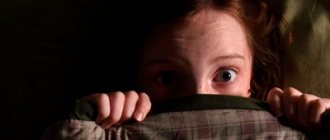In our article “Fear. What to do with him?" We talked in detail about fear, as well as what significance it has for a person. It was there that we explained why it is so important and necessary in the lives of each of us, why it is so good that it is characteristic of all of us. Today we would like to talk about fear, mostly non-judgmentally.
Regardless of whether fear is rational or irrational, you need to understand it in order to determine your further actions and generally be able to assess your condition. Therefore, it is necessary to learn the main features of fear. Next, we will tell you about what forms of fears exist and introduce them to the most common types.
Forms of fears
Fears can be classified according to different criteria. We will talk about some of them below, but for now we will consider the classification of emotional states that are in one way or another related to fear, based on the intensity, objectivity and strength of perception. Everything here is extremely simple, because you yourself are familiar first-hand with such things as:
- Calm. A state of complete emotional peace, when nothing worries a person, he is comfortable psychologically, he does not experience any negatively colored states associated with fear.
- Anxiety (fear, worry). A state in which a person feels the uncertainty of the situation and expects a bad turn of events. Most often, anxiety has no objective stimulus and is irrational.
- Excitement. A condition arising from anxiety and representing its intensified form. With it, a person experiences more intense nervous excitement, because doesn’t know what could happen to him and is afraid of it.
- Fear. A condition caused by a real or perceived threat. Let us remember that there is a healthy fear that warns against danger, and there is an unhealthy fear that has no basis. This is what you need to be able to cope with.
- Horror. A condition caused by intense fear. It can plunge a person into numbness, trembling, shock. A person’s active reaction to horror is absent; he is unable to eliminate the source of fear.
- Panic. A condition that is another extreme form of fear, but it is not expressed in numbness, but in the fact that a person begins to be controlled by his feelings. His actions are not subject to any logic and often harm him.
We can also identify another condition associated with fear. This is a state of fearlessness. In the case of a real threat, it can lead to extremely dire consequences. A state of fearlessness can be observed in people with an exaggerated and unhealthy sense of self-confidence, people who do not have a sense of self-preservation and suffer from mental disorders (we are not talking about situations where circumstances require being fearless).
But this is only an initial classification of fears, giving a general idea of how fear can be expressed in general. Next we present another classification - developed by the Soviet and Russian psychiatrist and psychotherapist Boris Dmitrievich Karvasarsky. He divided fears into eight large groups:
- Spatial fears (this includes bathophobia - fear of depth, acrophobia - fear of heights, agoraphobia - fear of open space, claustrophobia - fear of enclosed spaces, etc.)
- Social fears (this includes neophobia - fear of any change, heterophobia - fear of the opposite sex, etc.)
- Fear of diseases.
- Fear of death.
- Fear of sex.
- Fear of harming others.
- Fear of fears (it is this fear, by the way, that causes all phobias).
However, the classification of fears by B. D. Karvasarsky is quite complex and relative. The Austrian psychologist and psychiatrist Sigmund Freud approached the categorization of fears more specifically, dividing fears into two classes:
- real fears;
- neurotic fears.
Canadian-American psychiatrist Harold Irwin Kaplan classified fears in a similar way. He divided them into:
- constructive fears;
- pathological fears.
But the most interesting thing is that these two scientists agreed that the first fears (real and constructive) are necessary for a person so that he can save his own or someone else’s life, and the second (neurotic and pathological) can be considered as a sign of an illness that destroys a person .
There is also an interesting theory from stress research specialist Yuri Viktorovich Shcherbatykh, proposed by him in 2000. According to his concept, there are three types of fears:
- Natural fears. This includes everything that is justified by natural phenomena (hurricanes, earthquakes, tsunamis, thunderstorms, etc.). Such fears are completely justified and even adequate people are susceptible to them. It is human nature itself to fear everything unknown (we repeat once again that we talked about this in the article “Fear. What to do with it?”, as well as in the article “Psychological foundations of fear”). Despite the fact that today people perfectly understand the origin of most natural phenomena, fear of them remains, and it is natural. This category of fears also includes the fear of various animals, insects and other living creatures.
- Social fears. Yu. V. Shcherbatykh, taking as a basis the results of various sociological surveys, came to the conclusion that the greatest fear among people is, of course, the threat of war. And this fear is characteristic even of those who have never participated in hostilities. Among other social fears, he names fear of crime, hooliganism and disorder, fear for one’s loved ones, fear of death, fear of poverty, fear of public speaking and publicity in general, fear of change and some others.
- Inner fears. As children, many of us were frightened by some kind of woman or little gray wolf who would come and take us away if we did not obey. We have grown up, but many people still have the fear of looking in the mirror at night, looking under the bed, or pulling their leg out from under the blanket. A person’s imagination, which received the corresponding message in childhood, is capable of generating a variety of monsters that no spiders or hurricanes can compare with. And it is very, very difficult to stop being afraid of such things (by the way, read our article “What Famous People Were Afraid of,” where there is a lot of confirmation of what was said).
The line between these three groups of fears is very thin and extremely difficult to see. For example, if a person experiences internal fear of the quagmire that is sucking him in, it can to a certain extent be attributed to both social and natural fear. Fears can cleverly intertwine with each other and have an inexplicable impact on a person.
But the classification of fears does not end there, because there is also a gradation by age:
- Childhood fears. When a child just begins to live, his gene stock of reflexes works. So, the baby may be afraid of being thrown up when he hears loud noises or sees strangers. Such reactions are normal and constructive, but life moves on. If parental upbringing was incorrect or the child was influenced by some special circumstances, he may develop neurotic fears. For example, if a child was punished by being locked in a closet, he may develop claustrophobia, and if his mother once lost him in a shopping mall, he may begin to fear open spaces and large crowds of people.
- Fears of an adult. An adequate adult understands perfectly well that there is no Boogeyman in a dark closet, but he can be terrified by the mere sight of snakes, spiders or praying mantises. Likewise, he may be afraid that a loved one will leave him, or experience stage fright; to be afraid of being worse than others or to consider oneself unworthy of many benefits; overly control your other half or constantly worry about your children, etc.
- Fears of older people. The fears of older people may differ from those of children and adults. They are specific. In addition to the fear of the dark, mice and hurricanes, there may be a fear of getting sick and becoming a burden to your family. But at the same time, the fears that previously bothered us disappear, for example, the fear of being misunderstood by others, the fear of not experiencing love in life. However, some fears can go to extremes: grandmother, afraid of strangers, does not open the door even to her relatives, grandfather, fearing transport, does not come closer than 200 meters to the road, etc.
This is the primary classification of fears. In fact, this topic is worthy of more careful study and serious scientific work. But we only set ourselves the task of showing how diverse this unique phenomenon called fear is, and we hope that we were able to accomplish this task.
You can read about how to work with fears in the articles “Fear. What to do with him?" and “Method of systematic desensitization to combat fears,” and we will continue this material with very interesting information. As you know, fear can become uncontrollable and obsessive, i.e. develop into a phobia. So below we will talk about the most common phobias of people.
Symptoms
It is worth understanding the differences between fear, anxiety, anxiety and panic. Anxiety is not related to anything specific. “Uneasy at heart” - this is how this feeling can be explained. Anxiety accompanies a person at certain moments in life (at night, when visiting gloomy houses). Once in conditions that are comfortable for him, a person calms down. But if the patient has a fear of rain, he will not forget about his fear. Moreover, seeing rain on TV, the patient will feel a panic attack.
The phobia can provoke panic attacks in the patient
Fear can manifest itself in different ways, the forms of its expression “vary” from minor fear to a nervous cough, nausea, and fainting. Suggestible people sometimes pick up phobias from relatives. The patient, without having a negative experience, may experience panic about botulism. His mother, who had seen her childhood friend die before her eyes, was afraid of botulinum wound poisoning. The shock was deeply ingrained in the woman’s memory, and she “infected” her son with her emotional stories.
There are a huge number of types of fear in psychology - more than 1000. Some of them hardly bother people. The most terrible phobias for the physical health and mental well-being of an individual are panic before eating, fear of time, fear of falling asleep.
The most common phobias
A phobia is a manifestation of irrational fear or increased anxiety associated with real or expected objects or situations that cause fear. This is an obsessive state that worsens under specific conditions and cannot be explained logically. Under the influence of a phobia, a person is afraid and tries to avoid certain situations, activities or objects.
Below is a list of the most common phobias in alphabetical order:
- Agoraphobia is the fear of open spaces. People with this fear prefer to always be indoors.
- Aquaphobia is the fear of water. In its hypertrophied form, it can develop into a fear of drinking even a sip of water.
- Acrophobia – fear of heights. Fear causes climbing to any heights, from a stool to mountains.
- Arachnophobia is the fear of spiders. It is considered characteristic of most people in the world.
- Astraphobia is the fear of thunder and lightning. A very common fear that causes people to take shelter during a thunderstorm.
- Aerophobia is the fear of flying and aircraft. It is a hindrance for many people who want to travel.
- Hemophobia is the fear of the sight of blood. At the sight of blood, even on TV, a person with such a phobia may lose consciousness.
- Gerontophobia is the fear of old age. Most often, this fear is observed in middle-aged people.
- Homophobia is fear, or rather rejection, of homosexuality and people with non-traditional sexual orientation.
- Dentophobia is the fear of dentists. People with this phobia would rather endure severe toothache than sit in the dentist's chair.
- Kacorrhaphiophobia is the fear of failure. Characteristic mainly of people focused exclusively on success.
- Cynophobia – fear of dogs. Another type of phobia that is common to a huge number of people.
- Claustrophobia is the fear of closed spaces. A person with an aggravated form of this phobia begins to panic in an ordinary elevator.
- Xenophobia is the fear of strangers. It can develop on sexual, interracial and religious grounds.
- Mysophobia is the fear of germs and dirt. A person with this fear is uncomfortable touching any objects outside his home, where there is always perfect cleanliness.
- Monophobia is the fear of loneliness. It can be expressed as a fear of being abandoned by a loved one, being alone in the world, or being alone in a room.
- Necrophobia is the fear of the dead. A clear example of fear of the unknown.
- Nyctophobia is the fear of the dark. Despite the fact that it mainly affects children, it is also observed in a huge number of adults.
- Ophidiophobia is the fear of snakes. Another example of a common fear. It is a subtype of hypertophobia - fear of reptiles.
- Social phobia is the fear of public attention. This can even include the fear of appearing in public places.
- Thanatophobia is the fear of death. This fear paralyzes a person’s will and prevents him from living a normal life.
- Trypanophobia – fear of needles, pricks and injections. A regular vaccination becomes a test of strength for people with this phobia.
- Trypophobia is the fear of open wounds and any holes in the skin, both on one’s own and on the skin of any living organism in general.
We, of course, could list a dozen other common phobias, but if you wish, you can do your own little research, for example, read what people are afraid of on the Internet. And we will add some zest to our article and briefly list some of the strangest phobias found in the modern world:
- agmenophobia – fear that the queue a person is standing in will move slower than the one next to it;
- acribophobia - fear of not understanding the essence of what you read;
- hapotophobia – fear of being touched;
- hexakosioyhexekontahexaphobia – fear of the number “666”;
- genophobia – fear of intimacy;
- hippopotomonstrosesquipedalophobia – fear of long words;
- dextrophobia – fear of objects located on the right;
- decidophobia – fear of making decisions;
- Domatophobia – fear of houses and any buildings;
- dorophobia – fear of giving and receiving gifts;
- Ignorophobia – fear of not receiving a response to a message you read;
- Imojiphobia – fear of being misunderstood after sending an emoticon or sticker;
- cyberphobia – fear of computers;
- kumpunophobia – fear of buttons;
- Lacanophobia – fear of vegetables;
- macrophobia – fear of long waits;
- nephophobia – fear of clouds;
- nomophobia – fear of being without a smartphone;
- omphalophobia – fear of belly buttons;
- Papaphobia – fear of the Pope;
- penteraphobia - fear of mother-in-law;
- Pogonophobia – fear of beards;
- punctumophobia – fear of messages with a period at the end;
- reterophobia – fear of making a mistake in a word or not seeing an erroneous autocorrect;
- Selfiphobia – fear of taking a poor-quality selfie;
- social network phobia – fear of social networks;
- philophobia - fear of falling in love;
- Chairophobia – fear of laughing in inappropriate conditions;
- Chorophobia – fear of dancing;
- chronophobia – fear of time;
- epistemophobia – fear of gaining knowledge;
- Ergophobia – fear of any work.
And this list of phobias does not exhaust the topic, which suggests that it is possible to find some kind of fear, even in a mild form, in almost any person in the world. Moreover, with the passage of time and changes in the specifics of each era, new, sometimes completely absurd, fears appear.
Of course, we sincerely hope that no fears or phobias cause you discomfort in life. If this is still not the case, read our article “Fear. What should you do with him?” in order to better know your enemy and overcome him. However, getting acquainted with this article is useful and simply for general development.
We wish you good luck and successful work on yourself, no matter what it concerns!
We also recommend reading:
- Storytelling
- What is fear and how to overcome it
- Interesting and unusual facts about fear
- Overcoming Fear
- Psychology of fear
- How to overcome the fear of a white page
- Your main fear
- Fear: psychological foundations and famous scientific studies of this phenomenon
- Systematic desensitization method to combat fears
- How to cope with fear: a selection of useful materials
- How to deal with fears
Key words:1Psychoregulation
Main varieties
It would take a very long time to list all the fears in the world, but it is necessary to provide basic information about the types of panic attacks. Types of phobias:
- fears for health, various fears associated with space (limited or too wide);
- phobias of natural phenomena, panic fear of animals;
- fear of plants: fear of tall trees brings significant discomfort to people;
- phobias based on intimacy, childhood and teenage types of panic;
- food and drug phobias;
- panic moods, which are based on rejection of strangers and familiar people, fear of communication;
- rejection of a certain part of the body of other people (noses, large chins): it is worth recognizing that these are quite rare phobias;
- mystical fears;
- the strangest phobias in the world, such atypical fears include panic fear of the Pope, a painful rejection of the number 13.
A complete classification of phobias is available in psychology textbooks.
What is the person experiencing?
Every person is afraid of something, but not everyone has phobias. In psychology, a phobia is considered a pathologically increased manifestation of the fear reaction to a stimulus.
Signs of a phobia:
- panic;
- shiver;
- cardiopalmus;
- suffocation;
- feeling of heat;
- sweating;
- often - ringing in the ears.
Fear is not associated with a specific threat, but with a specific situation. The reaction of the human body may be such that it is impossible to move, and numbness sets in. Fears are 2 times more common in women than in men. Sometimes various anxiety states are also called phobias, although this is not entirely true.
It happens that children or women, wanting to be the center of attention, begin to be afraid of something, and gradually this becomes a habit. Sometimes a particular phobia causes a feeling of strong disgust, for example, to spiders or worms.
What phobias exist, and why are people scared of so many things? The reasons for this are memory, imagination and speech. It was a large number of fears and concerns that helped humanity survive and move forward. Obsessive fears vary in intensity. Despite their senselessness, coping with them is sometimes difficult. Existing phobias are systematized alphabetically, their names are in Greek and Latin.
Fear of mice and rats
Various types of fears develop in 14% of people at one stage or another in life. They can be harmless or cause health problems. Inspired phobias are considered the most dangerous. Suspicious people are more susceptible than others to the fear of getting sick. It is called pathophobia, or nosophobia. Severe fear can cause imaginary pain. Sometimes you can get out of this state only with the help of antidepressants. Nosophobes, getting rid of a non-existent disease, tend to self-medicate and this can seriously harm their health.
Phobias are studied by doctors, biologists, psychologists, philosophers, theologians, and linguists, each presenting them in their own way with many comments related to their profession.
There are fears caused by animals - zoophobia. People experience fear of various animals: spiders, cockroaches, snakes, dogs, cows, but most often mice (musophobia) and rats (zemmiphobia).
If the fear has gone very far, a person becomes sick from the sight of not only living rodents, but even Mickey Mouse, depicted in drawings, in the form of figurines or on a T-shirt. Zemmyophobia includes the fear of rats and moles. It may be caused by disgust at the sight of these animals. Zemmyophobes believe that they are planning an attack and will attack at any moment. Scientists believe that the fear of mice has long been passed down from generation to generation at the genetic level, as a warning about the danger of losing food supplies and contracting diseases.
Liberation from pathology
Specific phobias do not always require treatment. If the likelihood of meeting the Pope or seeing a gnome is negligible, the patient can hide his worries from others, drive away thoughts about the source of fear. But, if the patient has a fear of time that has developed into depression, the person needs psychotherapy sessions and special medications.
Children's fears are easier to treat than persistent phobias of adults. Parents often ask what to do if their child has phasmophobia, how to get rid of obsessive fear. It is possible that the child watched a movie about monsters and ghosts and now feels frightened when entering an unfamiliar room or a dark corridor. A boy can stop being afraid of ghosts if his mom and dad patiently and tactfully explain to him that such “monsters” do not exist. Humor helps you get rid of fear. By drawing a funny ghost and writing a couple of jokes about it, the child will get rid of painful experiences.
The main fears of childhood are being abandoned and forgotten. Other types of fears are generated by “basic” fears.
Fear of food (plant or animal origin) can be a real curse for a person. The patient, avoiding cottage cheese or meat that he hates, is afraid to even touch those foods next to which the “enemy” lay. To prevent a person from developing nervous disorders, psychotherapists sometimes use the method of hypnosis.
Many patients suffer from osmophobia (fear of smells). “How to get rid of it if everything around you stinks and irritates you – people, animals,” the patient complains. The following methods will help you free yourself from painful fear:
- cognitive psychotherapy;
- method of systematic desensitization: the essence is to gradually reduce a person’s sensitivity to “aggressors” (unloved odors).
If the patient has a fear of making decisions (decidophobia), treatment will consist of talking with a psychologist and strengthening self-esteem. To develop willpower and fight panic, you can enroll in yoga courses, take up an old hobby that you have abandoned (drawing, clay modeling).










